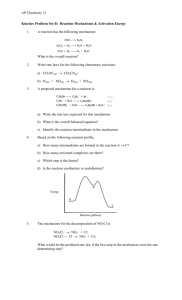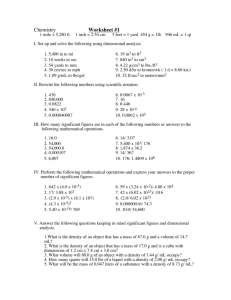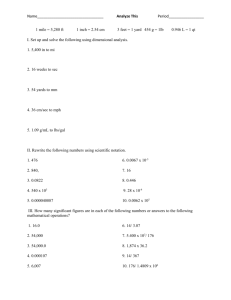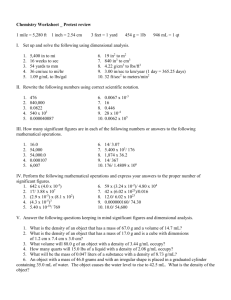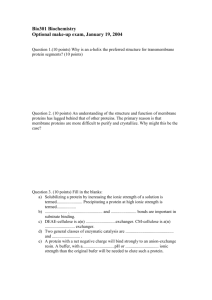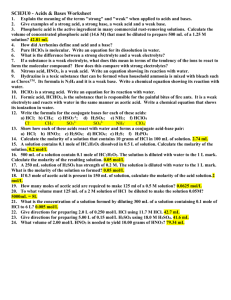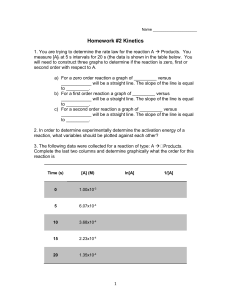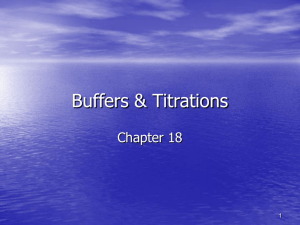Chemical Kinetics Problem Set 2
advertisement
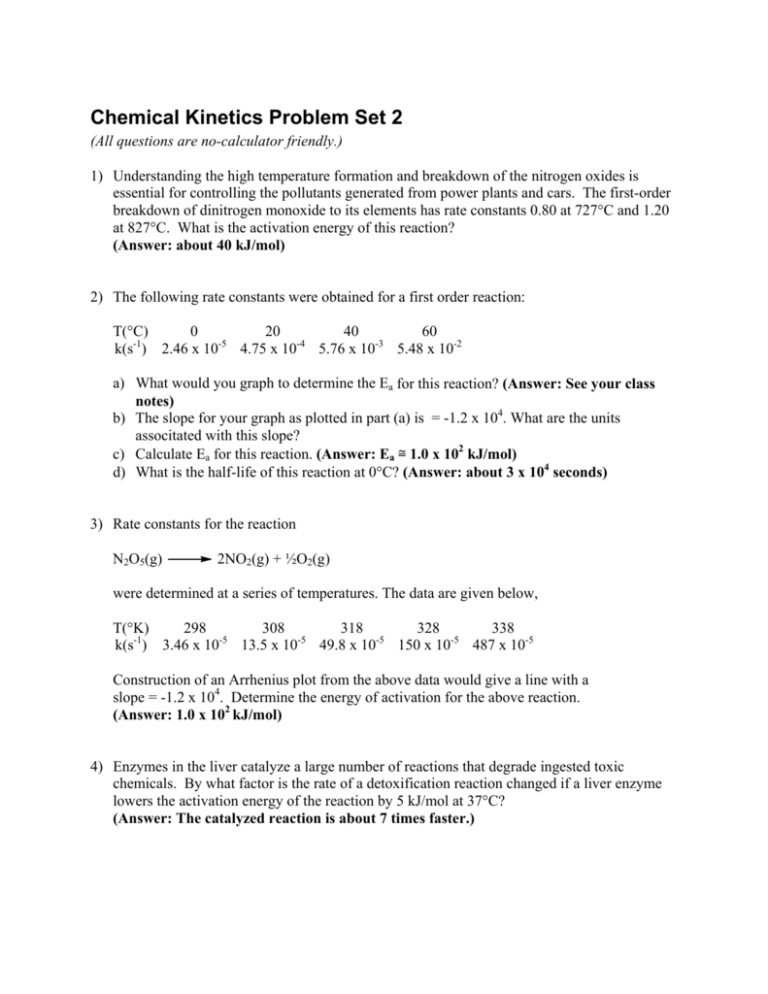
Chemical Kinetics Problem Set 2 (All questions are no-calculator friendly.) 1) Understanding the high temperature formation and breakdown of the nitrogen oxides is essential for controlling the pollutants generated from power plants and cars. The first-order breakdown of dinitrogen monoxide to its elements has rate constants 0.80 at 727°C and 1.20 at 827°C. What is the activation energy of this reaction? (Answer: about 40 kJ/mol) 2) The following rate constants were obtained for a first order reaction: T(°C) 0 20 40 60 k(s-1) 2.46 x 10-5 4.75 x 10-4 5.76 x 10-3 5.48 x 10-2 a) What would you graph to determine the Ea for this reaction? (Answer: See your class notes) b) The slope for your graph as plotted in part (a) is = -1.2 x 104. What are the units associtated with this slope? c) Calculate Ea for this reaction. (Answer: Ea ≅ 1.0 x 102 kJ/mol) d) What is the half-life of this reaction at 0°C? (Answer: about 3 x 104 seconds) 3) Rate constants for the reaction N2O5(g) 2NO2(g) + ½O2(g) were determined at a series of temperatures. The data are given below, T(°K) 298 308 318 328 338 k(s-1) 3.46 x 10-5 13.5 x 10-5 49.8 x 10-5 150 x 10-5 487 x 10-5 Construction of an Arrhenius plot from the above data would give a line with a slope = -1.2 x 104. Determine the energy of activation for the above reaction. (Answer: 1.0 x 102 kJ/mol) 4) Enzymes in the liver catalyze a large number of reactions that degrade ingested toxic chemicals. By what factor is the rate of a detoxification reaction changed if a liver enzyme lowers the activation energy of the reaction by 5 kJ/mol at 37°C? (Answer: The catalyzed reaction is about 7 times faster.) 5) Write a rate equation, showing the dependence of rate on reactant concentrations, for each of the following elementary reactions: k a) CS2 CS + S k CH3OH + Br-1 b) CH3Br + OH-1 (Answers: (a) Rate = k[CS2]; (b) Rate = k[CH3Br][OH-1]) 6) The thermal decomposition of nitryl chloride, NO2Cl, 2NO2(g) + Cl2(g) 2NO2Cl(g) is thought to occur by the following mechanism: k1 NO2Cl NO2 + Cl (slow step) k2 NO2Cl + Cl NO2 + Cl2 (fast step) What rate law is predicted by this mechanism? (Answer: Rate = k1[NO2Cl]) 7) The oxidation of nitric oxide by oxygen 2NO(g) + O2(g) 2NO2(g) may have the following mechanism: K NO3 (fast equilibrium) NO + O2 k NO3 + NO 2NO2 (slow step) Derive the rate law from this mechanism. What will kobserved be in terms of the equilibrium constant (K) and the rate constant k? (Answer: Rate = kK[NO]2[O2] where kobs = kK) 8) Nitramide, O2NNH2, decomposes slowly in aqueous solution according to the equation N2O + H2O O2NNH2 The experimental rate law is [O NNH 2 ] d [ N 2O ] =k 2 dt [ H 3O + ] Which of the following proposed mechanisms is consistent with the experimental rate law? N2O + H2O a) O2NNH2 k1 + O2NNH3+ + H2O b) O2NNH2 + H3O (fast) k2 k3 O2NNH3+ N2O + H3O+ (slow) k1 O2NNH-1 + H3O+ c) O2NNH2 + H2O (fast) k2 O2NNH-1 + H3O + OH k3 -1 N2O + OH-1 (slow) k4 2H2O (Answer: Mechanism (c)) (fast) 9) The catalytic destruction of ozone occurs via a two-step mechanism, where X can be any of several species: k1 X + O3 XO + O2 (slow) X + O2 (fast) k2 XO + O a) b) c) d) Write the overall reaction. Write the rate law for each step. What are the roles of X and XO in the mechanism above? High-flying aircraft release NO into the atmosphere, which catalyzes this process. When the O3 and NO concentrations are 5.0 x 1012 molecules/cm3 and 1.0 x 109 molecules/cm3 respectively, what is the rate of O3 depletion? The rate constant (k) for the process is 6.0 x 10-15 cm3/molecule-second. e) Is the O3 concentration in part (d) reasonable for this reaction, given that the concentration of stratospheric O3 never exceeds 10 mg/L? (Answers: 2O2 (a) O3 + O (b) For step 1: rate = k1[X][O3] For step 2: rate = k2[XO][O] (c) X is a catalyst and XO is an intermediate (d) 3 x 107 molecules/cm3-sec (e) It is a reasonable value since 10 mg/L = 1.3 x 1017 molecules/cm3) 10) Acetone is one of the most important solvents in organic chemistry, used to dissolve everything from fats and waxes to airplane glue and nail polish. At high temperatures it decomposes in a first-order process to methane and ketene (H2C=C=O). At 600°C, the rate constant is 8.7 x 10-3 s-1. a) What is the half-life of the reaction at 600°C? b) How much time is required for 75% of a sample of acetone to decompose? c) How much time is required for 90% of a sample of acetone to decompose? (Answers: (a) t½ ≅ 80 seconds (b) about 1.6 x 102 seconds (c) about 2.5 x 102 seconds)

